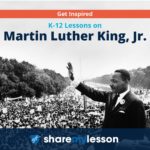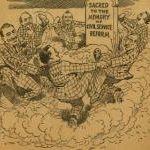In this lesson students have the opportunity to discuss how words have the power to bring about political, social, or economic change in society. By reviewing quotations from various leaders, activists, and others, students can begin to understand how ideas have an impact on the hearts and minds of people and can be a catalyst for change. Finally, students will reflect on the words of Martin Luther King Jr. and determine their relevance to the political, social, and economic issues of today.
Provide for the General Welfare – Interstate Highway and Defense Act
In the Constitution, Congress is charged with providing for the general welfare of the country’s
citizens. Historically, this has meant improving transportation, promoting agriculture
and industry, protecting health and the environment and seeking ways to solve social and
economic problems. In 1956, Congress passed the Federal-Aid Highway Act, popularly known as the National Interstate and Defense Highways Act, authorizing federal funding for the extension and
construction of a robust network of interstate highways. This project was one of the largest public
works in U.S. history establishing key transportation infrastructure that impacted lives of all
Americans — changing communities, access and economic possibilities and also providing key
routes for evacuating urban centers — a critical national defense issue in the Cold War era.
Analyzing primary source material, students discuss the origins and reasons for the National
Interstate and Defense Highways Act. Then, they work with historical and contemporary maps
as they consider the impact this important congressionally funded project. While intended for 8th
grade students, the lesson can be adapted for other grade levels.
1968: The Poor People’s Campaign
1968 was a tumultuous period in the United States. The Vietnam War, political assassinations and civil rights issues were among some of the challenges the country faced as solutions were sought. At this time, Martin Luther King Jr. organized the Poor People’s Campaign to shift the focus of the civil rights movement to economic issues; however, Reverend King was assassinated weeks before the campaign got underway in Washington, D.C. In this lesson, students will learn about the circumstances that gave rise to this campaign and how it is relevant today.
Women & the American Story: Confidence and Crises, 1920-1948
This free curriculum unit from the New-York Historical Society considers what it meant to be American in the decades following World War I. Materials focus on the tensions caused by the social, economic, and political shifts of the era and how women took action on a broad array of issues.
Founding Documents: The Constitution Podcast
After just six years under the Articles of Confederation, a committee of anxious delegates agreed to meet in Philadelphia to amend the government. The country was in an economic crisis — citizens couldn’t pay their debts, the government couldn’t really collect taxes, and rebellions were cropping up in states across the nation. The existing government had the potential to drive the country to ruin. So fifty-five men gathered to determine the shape of the new United States.
The document that emerged after that summer of debate was littered with masterful planning, strange ideas and unsavory concessions. The delegates decided they’d be pleased if this new government lasted fifty years. It has been our blueprint for over two centuries now. This is the story of how our Constitution came to be.
This short episode includes a one-page Graphic Organizer for students to take notes on while listening, as well as discussion questions on the back side.
Martin Luther King Lesson Plans and Resources: Understanding a Life and Legacy

Education was integral to Dr. King’s vision for a more just society, and working to ensure that dream comes true is integral to America’s educators today. Share the influential ideas of this towering figure of the civil rights movement who envisioned racial, economic and social justice for America by espousing non-violent, collective action that would change society forever. Share My Lesson’s updated collection features curated lesson plans, resources and activities to help your prek-12 students explore Dr. King’s commitment to the labor movement and the fight for justice and dignity.
In Pursuit of Equity: Women, Men, and the Quest for Economic Citizenship in 20th-Century America
Alice Kessler-Harris of Columbia University discusses citizenship for men and women in the context of the Industrial Revolution and increasing economic tensions.
What Does It Mean to Be a Good Citizen?
This is the first lesson in Khan Academy’s new high school civics course. This lesson focuses on what it means to be a good citizen, what civil society is, and what are democratic principles and civic virtues.
Civil Service Reform: Creating a Merit System for Pennsylvania

The Gilded Age of the late 19th century is not typically recalled as an age of reform. Characterized by industrialization, urbanization, and rapid population growth, it was an era of remarkable economic expansion. The Gilded Age also saw a dramatic expansion in the size and scope of government—the federal government employed just 53,000 people in 1871, but numbered 256,00 employees by 1900. Patronage politics was the norm, at every level of government.
Different Perspectives on the Civil Rights Movement
Anthony Badger uses the career of President Jimmy Carter to frame the questions of change in the American South and the relative impact that economic modernization, nonviolent protest, and armed self-defense had on the end of segregation and the steps taken toward political and social equality. Free registration for students and teachers required to access resource.